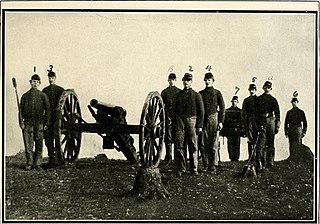| Battery C, 1st New Jersey Light Artillery | |
|---|---|
| Active | September 11, 1863 to June 19, 1865 |
| Country | United States |
| Allegiance | Union |
| Branch | Artillery |
| Engagements | Siege of Petersburg First Battle of Deep Bottom Battle of Fort Stedman Appomattox Campaign |
Battery C, 1st New Jersey Light Artillery was an artillery battery that served in the Union Army during the American Civil War.
The battery was organized in Trenton, New Jersey and mustered in for a three-year enlistment on September 11, 1863 under the command of Captain Christian Woerner.
The battery was attached to Barry's Artillery Command, XXII Corps, Defenses of Washington, to May 1864. Abercrombie's Command, Army of the Potomac, to June 1864. Artillery Brigade, II Corps, to September 1864. Artillery Reserve, Army of the Potomac, to June 1865.
Battery C, 1st New Jersey Light Artillery mustered out of service June 19, 1865.
Left New Jersey for Washington, D.C., September 25, 1863. Duty in the defenses of Washington, D. C., until May 1864. Moved to Belle Plain, Va., May 11–Grand Review of the Armies May 23.
The battery lost a total of 12 men during service; 8 enlisted men killed or mortally wounded, 4 enlisted men died of disease.
6th Maine Light Artillery Battery was an artillery battery that served in the Union Army during the American Civil War.
7th Maine Light Artillery Battery was an artillery battery that served in the Union Army during the American Civil War.
1st New Hampshire Light Artillery was an artillery battery that served in the Union Army during the American Civil War.
Battery E, 1st Rhode Island Light Artillery Regiment was an artillery battery that served in the Union Army during the American Civil War.
Battery G, 1st Rhode Island Light Artillery Regiment was an artillery battery that served in the Union Army during the American Civil War.
Battery H, 1st Rhode Island Light Artillery Regiment was an artillery battery that served in the Union Army during the American Civil War.
16th Indiana Battery Light Artillery was an artillery battery that served in the Union Army during the American Civil War.

1st Connecticut Heavy Artillery Regiment was an artillery regiment that served in the Union Army during the American Civil War.

The 2nd New York Heavy Artillery Regiment was a heavy artillery regiment that served in the Union Army during the American Civil War. During the Siege of Petersburg the regiment operated as infantry.
The 4th New York Heavy Artillery Regiment, U.S. Volunteers was a heavy artillery regiment that served in the Union Army during the American Civil War. The regiment operated as both heavy artillery and infantry beginning in February 1862 while serving in the defenses of Washington, D.C., and continued in both capacities until the end of the war.
The 10th Massachusetts Battery was an artillery battery that served in the Union Army during the American Civil War.
Battery A, 1st New Jersey Light Artillery was an artillery battery that served in the Union Army during the American Civil War.
Battery B, 1st New Jersey Light Artillery was an artillery battery that served in the Union Army during the American Civil War.
Battery G, 1st New York Light Artillery was an artillery battery that served in the Union Army during the American Civil War.
The 11th Independent Battery, New York Volunteer Light Artillery or 11th New York Light Artillery was an artillery battery that served in the Union Army during the American Civil War.
The 12th Independent Battery, New York Volunteer Light Artillery was an artillery battery that served in the Union Army during the American Civil War.
Battery A, 1st Pennsylvania Light Artillery was a light artillery battery that served in the Union Army as part of the Pennsylvania Reserves infantry division during the American Civil War.
Battery B, 1st Pennsylvania Light Artillery was a light artillery battery that served in the Union Army as part of the Pennsylvania Reserves infantry division during the American Civil War.
The 3rd Independent Battery, New York Volunteer Light Artillery or New York Independent Light Artillery was an artillery battery that served in the Union Army during the American Civil War.

The 34th Independent Battery New York Light Artillery was an artillery battery that served in the Union Army during the American Civil War. The unit was organized as Battery L, 2nd New York Heavy Artillery, but was soon detached as an independent light battery. The battery fought at Cedar Mountain, Second Bull Run, Antietam, and Fredericksburg in 1862. Battery L moved to the Western Theater where it served at Vicksburg, Jackson, and Knoxville in 1863. Now named the 34th Battery, it transferred back to the Eastern Theater where it fought at the Wilderness, Spotsylvania, North Anna, Totopotomoy, Cold Harbor, and Petersburg. The unit took part in the Appomattox campaign and the Grand Review of the Armies before being mustered out in June 1865.